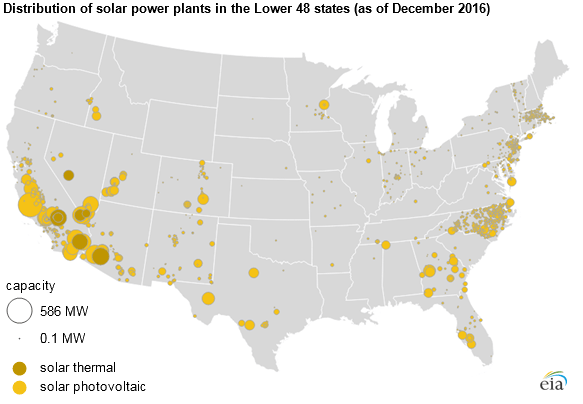Background
As renewable generation has reached a point of financial viability and strategic success in the energy industry, a supporting industry of companies with supporting tools have arisen to help usher in this new era of electricity. Despite the advent of new technologies, there are still large areas of opportunity for industry improvement. Renewable development is still very expensive and time consuming.
Renewable generation still represents a fairly small percentage of the United States’ overall generation profile. According to the Energy Information Agency (EIA), renewable generation represented roughly 17% of total generation in the first half of 2016. This is significant improvement from the roughly 14% in 2015, however, there is still a long way to go.
Utility-scale solar only makes up 0.9% of electricity generation, but there was an increase of over 50% of solar generation capacity in 2016. A variety of factors have influenced significant solar adoption such as state incentives, federal tax credits, renewable portfolio standards, and decreased panel and installation costs. Around 70% of these new solar facilities are found in California, with New Jersey and Massachusetts at 17% and 13% respectively. The following image from the EIA shows the location of all utility-scale solar generation in the United States.

Why aren’t renewables catching on quicker?
Although society has become more supportive of renewable energy in recent years, there are still various barriers that are slowing rates of adoption. There are four overarching areas that are holding back the renewable energy industry as described by the Union of Concerned Scientists:
- Commercialization: Difficulty driven by new technology competing with mature technology and incumbent organizations
- Price Distortions: Distorted subsidies between renewable and traditional generation
- Market Failure: Society not fully grasping the public benefits of renewables
- Market Barriers: A lack of resources, information, and high transaction costs
Commercialization & Siting Barriers
All of the barriers outlined above have significant time horizons until they are fully solved. Price distortions must be fixed through slow political processes, while market failures and market barriers are generally fixed through larger-scale adoption and economies of scale.
However, commercialization is one area where organizations can more quickly develop solutions. The lack of developed renewable infrastructure relative to traditional generation is a key issue in regards to commercialization.
Developing nationwide renewable infrastructure is difficult. Every renewable asset comes with a significant price tag and an immense human capital investment related to siting, permitting, marketing, installation, operation, and maintenance activities. Since renewable energy is still reasonably new, the industry is still forming operational best practices.
Siting processes are within the infrastructure category and are ripe for improvement. Siting - the activity of finding an ideal location for a new renewable facility - is a laborious process despite industry advancement. Although it is tedious, it is absolutely essential, and with new technology
Difficulties of Prospecting
Every organization has a unique process for analyzing potential development locations. However, despite differing tactics, there are consistent issues that make prospecting difficult regardless of methodology.
Feasibility Analysis & Voltage
A critical prospecting task is to find a substation that is suitable for interconnection with the bulk power system. Early on, projects go through a feasibility study to ensure the renewable development won’t negatively impact the power grid and hurt reliability.
The primary criteria for a substation interconnect is voltage class. As a renewable project increases in capacity, the voltage class you interconnect with will increase as well. For a solar field under 100 MW, a developer may aim to go in at 69 kV to 138 kV. If the field increases past 100 MW, the likelihood of a successful interconnect will go down at a 138 kV substation, and the developer will instead be searching for 230 kV and above.
The next important criteria for a suitable substation is existing capacity at the substation and space for building out the interconnect. If there are empty bays at the substation, the interconnect design may be fairly straightforward, with only the addition of breakers needed. Even though the technical design of the process may be straightforward, the expenses of these components and the work to install will need to be allocated between the utility and the developer.
Once developers identify a substation with proper voltage and capacity, they must examine the nearby transmission infrastructure. For most utility-scale fields, there is enough electricity generation that the electricity will not have strictly local consumption. Transmission capacity must be available on the nearby high-voltage infrastructure to haul the electricity to neighboring regions for consumption.
Feasibility studies can take upwards of two years to complete for a single location. It involves many conversations between the developer and utility in order to complete the analysis and ensure the grid will remain reliable and the electricity is useful.
Site Identification is Manual and Laborious
During the feasibility study, the developer is attempting to secure land to build the generating field, which creates risk.
In order to secure land for the site, developers need historically need people in the region investigating the area and talking with landowners to find a suitable parcel. This is often done by consultants, which is expensive and time consuming. If a developer is unsure whether the feasibility study will be positive, these could be wasted resources.
Historically, there haven't been many tools to assist with prospecting. Organizations often send analysts to manually canvas regions of interest to locate substations. From there, they dig through property records to find land positions in nearby areas and manually cross reference the data with GIS information.
Even more advanced processes that rely on applications like Google Earth and GIS layers take significant time to manage internally and are difficult to scale.
Ultimately developers have made these processes work, but their methodology is inefficient and outdated. While there will always be a need for on-site analysis, an industry tool that better directs resources and minimizes costly canvassing and automates internal processes will benefit the industry.
Moving Forward
It is difficult for the renewable industry to proliferate at an ideal pace when these types of inefficienciencies exist throughout the value chain. Creating repositories of substation and land data will help to increase prospecting efficiency and reduce the necessity of manual canvassing efforts. Although there are countless ways to continue advancing renewable energy, siting optimization is an area where even moderate advancement could pay significant dividends.
To read more on how we at Anderson Optimization are helping improve these processes, check out our follow-up piece on our siting automation product: AOProspect





